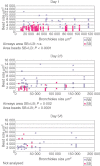Bead-size directed distribution of Pseudomonas aeruginosa results in distinct inflammatory response in a mouse model of chronic lung infection
- PMID: 23039893
- PMCID: PMC3482369
- DOI: 10.1111/j.1365-2249.2012.04652.x
Bead-size directed distribution of Pseudomonas aeruginosa results in distinct inflammatory response in a mouse model of chronic lung infection
Abstract
Chronic Pseudomonas aeruginosa lung infection in cystic fibrosis (CF) patients is characterized by biofilms, tolerant to antibiotics and host responses. Instead, immune responses contribute to the tissue damage. However, this may depend on localization of infection in the upper conductive or in the peripheral respiratory zone. To study this we produced two distinct sizes of small alginate beads (SB) and large beads (LB) containing P. aeruginosa. In total, 175 BALB/c mice were infected with either SB or LB. At day 1 the quantitative bacteriology was higher in the SB group compared to the LB group (P < 0·003). For all time-points smaller biofilms were identified by Alcian blue staining in the SB group (P < 0·003). Similarly, the area of the airways in which biofilms were identified were smaller (P < 0·0001). A shift from exclusively endobronchial to both parenchymal and endobronchial localization of inflammation from day 1 to days 2/3 (P < 0·05), as well as a faster resolution of inflammation at days 5/6, was observed in the SB group (P < 0·03). Finally, both the polymorphonuclear neutrophil leucocyte (PMN) mobilizer granulocyte colony-stimulating factor (G-CSF) and chemoattractant macrophage inflammatory protein-2 (MIP-2) were increased at day 1 in the SB group (P < 0·0001). In conclusion, we have established a model enabling studies of host responses in different pulmonary zones. An effective recognition of and a more pronounced host response to infection in the peripheral zones, indicating that increased lung damage was demonstrated. Therefore, treatment of the chronic P. aeruginosa lung infection should be directed primarily at the peripheral lung zone by combined intravenous and inhalation antibiotic treatment.
© 2012 British Society for Immunology.
Figures








References
-
- Jensen PO, Givskov M, Bjarnsholt T, Moser C. The immune system vs. Pseudomonas aeruginosa biofilms. FEMS Immunol Med Microbiol. 2010;59:292–305. - PubMed
-
- Schmiedl A, Kerber-Momot T, Munder A, Pabst R, Tschernig T. Bacterial distribution in lung parenchyma early after pulmonary infection with Pseudomonas aeruginosa. Cell Tissue Res. 2010;342:67–73. - PubMed
-
- McCullagh A, Rosenthal M, Wanner A, Hurtado A, Padley S, Bush A. The bronchial circulation – worth a closer look: a review of the relationship between the bronchial vasculature and airway inflammation. Pediatr Pulmonol. 2010;45:1–13. - PubMed
MeSH terms
Substances
LinkOut - more resources
Full Text Sources
Medical

